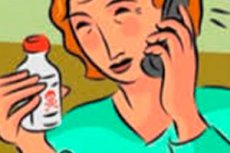Medical expert of the article
New publications
Ammonia vapor poisoning
Last reviewed: 29.06.2025

All iLive content is medically reviewed or fact checked to ensure as much factual accuracy as possible.
We have strict sourcing guidelines and only link to reputable media sites, academic research institutions and, whenever possible, medically peer reviewed studies. Note that the numbers in parentheses ([1], [2], etc.) are clickable links to these studies.
If you feel that any of our content is inaccurate, out-of-date, or otherwise questionable, please select it and press Ctrl + Enter.

Ammonia (ammonia, 10% solution of ammonium hydroxide) is a liquid colorless substance with a specific unpleasant odor. Damage to the body most often occurs when the drug is used incorrectly.
Symptoms of the ammonia poisoning
Intoxication is possible at work associated with ammonia alcohol or its use. Harm to the body occurs when vapors are inhaled for longer than 10 seconds. The main signs of exposure to toxin vapors include:
- Respiratory distress.
- Coughing and shortness of breath.
- Lung wheezing.
- Spasmodic bronchial pain.
- Dizziness.
- Movement disorder.
- Fainting.
- Body heat.
- Panic attacks.
- Nausea and vomiting.
- Hallucinations.
- Disorders of the visual system.
- Nervous excitement.
If the victim has diseases of the respiratory or cardiovascular system, there is a risk of serious and irreversible effects on the body. Prolonged inhalation of ammonia is a lethal risk.
If the substance was ingested, a dosage of 50 ml is fatal for a person. The first thing the victim feels is acute abdominal pain, gagging, increased secretion of saliva and sweat, and impaired coordination of movements. Then there is a blockage of the larynx and trachea, which makes it impossible to inhale or exhale. Blood pressure gradually decreases, hallucinations, fainting and death occur.
Treatment of the ammonia poisoning
First aid for the victim is to ensure fresh air supply. If the patient has no pain behind the sternum or in the stomach, then lavage is carried out by inducing vomiting (for this purpose, a large amount of liquid with the addition of 1% acetic or citric acid is consumed). The main treatment is carried out in the intensive care unit or in the toxicology department.
In the hospital, the patient is given inhalation of oxygen or vaporized acidic solutions. It is also shown gastric lavage using a probe. Subsequently, analgesics, anti-edema and other medications are prescribed. Treatment continues until the full restoration of the functioning of vital organs and systems. If the pathological condition is left without medical help, it can lead to irreversible disorders of the CNS, malfunctions in the brain, pathologies of the visual and auditory systems.

